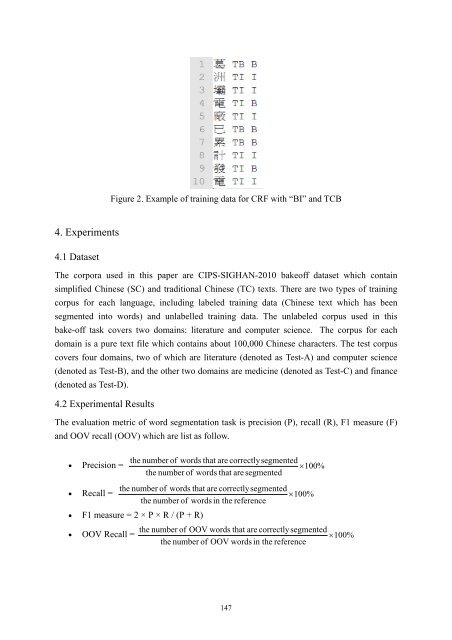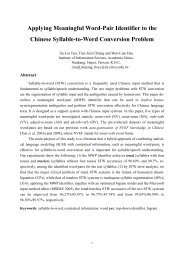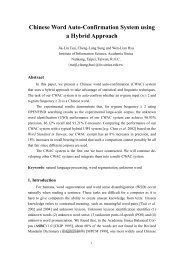Term Contributed Boundary Feature using ... - Academia Sinica
Term Contributed Boundary Feature using ... - Academia Sinica
Term Contributed Boundary Feature using ... - Academia Sinica
Create successful ePaper yourself
Turn your PDF publications into a flip-book with our unique Google optimized e-Paper software.
Figure 2. Example of training data for CRF with “BI” and TCB<br />
4. Experiments<br />
4.1 Dataset<br />
The corpora used in this paper are CIPS-SIGHAN-2010 bakeoff dataset which contain<br />
simplified Chinese (SC) and traditional Chinese (TC) texts. There are two types of training<br />
corpus for each language, including labeled training data (Chinese text which has been<br />
segmented into words) and unlabelled training data. The unlabeled corpus used in this<br />
bake-off task covers two domains: literature and computer science. The corpus for each<br />
domain is a pure text file which contains about 100,000 Chinese characters. The test corpus<br />
covers four domains, two of which are literature (denoted as Test-A) and computer science<br />
(denoted as Test-B), and the other two domains are medicine (denoted as Test-C) and finance<br />
(denoted as Test-D).<br />
4.2 Experimental Results<br />
The evaluation metric of word segmentation task is precision (P), recall (R), F1 measure (F)<br />
and OOV recall (OOV) which are list as follow.<br />
the number of words that are correctly segmented<br />
• Precision = × 100%<br />
the number of words that are segmented<br />
the number of words that are correctly segmented<br />
• Recall = × 100%<br />
the number of words in the reference<br />
• F1 measure = 2 × P × R / (P + R)<br />
the number of OOV words that are correctly segmented<br />
• OOV Recall = × 100%<br />
the number of OOV words in the reference




